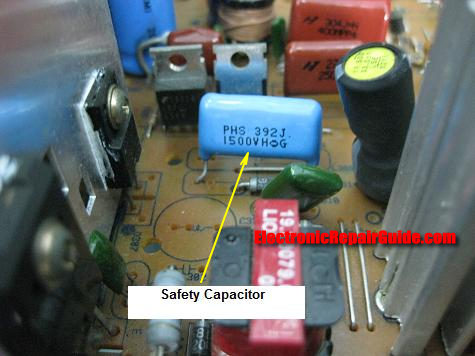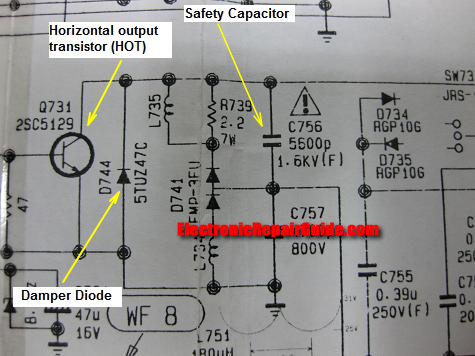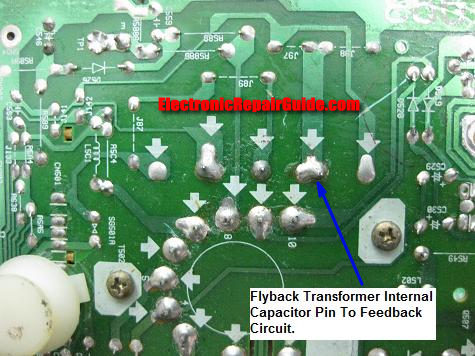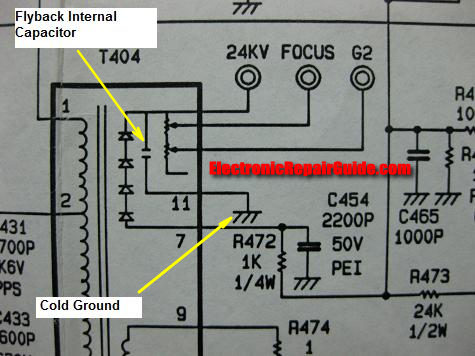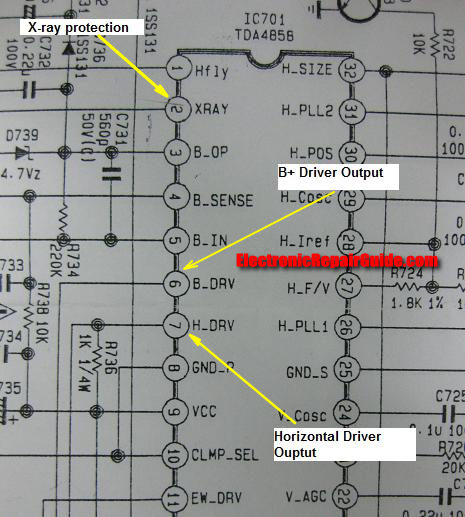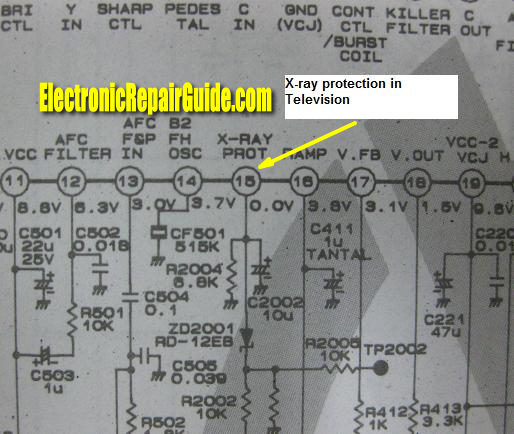|
Understanding The High Voltage And The X-Ray Protection Circuit In CRT Monitor Ever wonder why a CRT Monitor can shutdown on its own when the high voltage from the flyback transformer surpass the specification of 24 Kilovolt (KV)? The power light will still be on but the high voltage already gone down to very low voltage after it had shutdown or even down to zero volt. What makes the high voltage to increase and how this shutdown circuit works? You will find the answer in this article and you could apply this troubleshooting method to even Television and other equipment that have the shutdown circuit. Let’s begin!
What Makes The High Voltage To Increase?
Under normal working condition, in order to get the 24 KV from the flyback transformer there are three requirements needed:
1) The flyback transformer must be in good condition ie; the primary and secondary winding should have no shorted turns and the internal capacitor should have a capacitance between 2.7 nanofarad to about 4.5 or 6 nano farad. The Capacitance value of the internal capacitor is wholly depends on the size and the model of a Monitor.
2) The B+ voltage from the switch mode power supply (SMPS) have to enter one of the point of the Flyback transformer primary winding and the B+ voltage have to be according to the Monitor specification. Different Monitors have different B+ voltage value.
3) The horizontal output transistor (HOT) base pin must have a signal from the horizontal driver output (horizontal oscillator IC) in order to switch the HOT.
That means if a good fly back transformer receives a correct B+ voltage and a base drive waveform to HOT, the primary winding will be energized and you can expect 24 Kv output at the anode-it’s as simple as that!
The question now is why the output of the flyback transformer can increase? Simple, the higher the B+ voltage the higher will be the output. In other words, there must be a problem with the SMPS that had increased the B+ voltage thus increasing the output voltage. In the newer type of CRT Monitor that is using the Boost or Buck circuit, any of these conditions could increase the high voltage;
1) Shorted Buck circuit FET like the IRF9610, IRF9620 and etc will send a high B+ voltage to the primary winding thus increasing the anode voltage.
2) A wrong gate signal from the B+ driver output (in horizontal/oscillator IC) to the Boost circuit FET will increase the B+ voltage to the flyback transformer thus increasing the output at the anode.
3) Now, besides the increasing of the B+ voltage that increase the output voltage of the anode, I came across many times that the holdown/safety capacitor open circuit (zero capacitance value) also would cause the anode output voltage to increase but this will usually blows up the HOT. That means if you come across a shorted HOT please make sure to check the holdown/safety capacitor before put in a new HOT and turn the Monitor On.
4) If the flyback transformer internal capacitor have problem (low or zero capacitance value) and if the internal capacitor pin feedbacks to the B+ circuit (instead to cold ground) that controls the B+ output voltage then the anode output voltage will increase.
How Shutdown Circuit Works?
Thanks to the designer that have created the X-ray protection circuit. Just imagine if the anode voltage increase to more than 30 KVDC and the Monitor did not shutdown, the user will be exposed to the harmful x-ray radiation and prolong of using the Monitor will cause sickness to the user.
All flyback transformer have secondary winding, and if the B+ voltage has increase and enters the primary winding then obviously the secondary voltage will increase too. The increment of the secondary voltage triggers the X-ray protection circuit in the horizontal/vertical oscillator IC thus shutting off the horizontal driver output waveform to HOT. If the base of the HOT did not get the horizontal drive waveform it will not switch and the function of the flyback transformer will cease. Once the flyback transformer had stopped to energize then there will be no more output from the anode.
All this happen very fast -within a second or two and that’s why when you turn on the Monitor/Television you could feel the high voltage rushing out (energized) and then suddenly could hear the high voltage collapse. If you have the high voltage probe, the pointer will quickly points to more than 24 KVDC and once shutdown the pointer will move back to 0 volt.
Note: Generally the bigger size of the CRT Monitor/Television the higher is the high voltage. I came across a 17” Monitor model that have 28 KVDC and it is normal.
Do you know that if the X-ray protection circuit itself have problem would also cause the Monitor to shutdown? Yes, assuming along the X-ray Protection circuit have bad components, it will automatically shutdown the function of the horizontal driver output circuit thus no waveform will be produced for the HOT.
Warning!!!!
If you come across any Monitor/Television that have the high voltage shutdown problem and you can’t find out the cause then please do not disable the X-ray protection pin at the horizontal/oscillator IC or modify the circuit because it will be very dangerous to USER! If you can’t repair the Monitor just send back to the customer or send it to someone that can do the job. It is wrong (not ethical) to do such a job that put the user in a high risk situation just for the purpose of earning some profit!
Conclusion-If you come across any electronic equipment that can shutdown by itself (the power LED is still lit) I suggest that you take this article as a guidance to find out the fault and if possible get the schematic diagram of that equipment to analyze the circuit to find out how it shutdown. It will be an interesting journey and with great satisfaction if you could locate from your research how the equipment could shutdown on its own. All the best to you my friend-take care!
Click here to learn how you can become a Professional in Testing Electronic Components
Click here to learn how you can become a Professional in LCD Monitor Repair
Recommendation:
Recommended Mr Kent Projection Television Repair Membership website-Visit Now!
Recommended Mr Kent LCD TV Repair Membership website-Visit Now!
Recommended Mr Kent Plasma TV Repair Membership website-Visit Now!
|
|
Copyright@ 2006-2014-www.ElectronicRepairGuide.com All Rights Reserved

